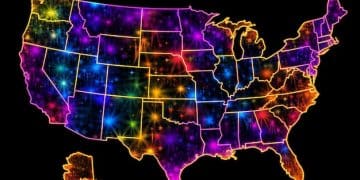Unlocking US Streaming: A 2025 Guide to Regional Content Restrictions

Navigating regional content restrictions in 2025’s US streaming landscape requires understanding geo-blocking technologies, legal frameworks, and effective access strategies to unlock diverse entertainment libraries.
In 2025, the world of online entertainment increasingly relies on streaming services, offering a vast array of content at our fingertips. Yet, the promise of unlimited access often collides with the reality of geographical restrictions. For those in the United States, understanding how to navigate and potentially overcome these barriers is key to truly Unlocking US Streaming: A Comprehensive Guide to Regional Content Restrictions in 2025. This guide delves into the mechanisms behind these limitations, their implications, and the solutions emerging to provide a truly global viewing experience.
The Digital Borders: Understanding Geo-fencing in Streaming
Geo-fencing, or geo-blocking, is the primary technology streaming services use to restrict content availability based on a user’s geographical location. This digital segmentation isn’t arbitrary; it’s a complex web driven by licensing agreements, distribution rights, and sometimes even local regulations. For US streamers, this means the content library on offer can differ significantly from what’s available in, say, Europe or Asia, even within the same streaming platform.
These restrictions are enforced through various technical means that identify a user’s location. The most common methods involve analyzing an IP address, which acts like a digital postcode for your internet connection. Other, more sophisticated techniques can also be employed, creating a robust defense against unauthorized access.
Licensing Agreements and Distribution Rights
At the heart of regional restrictions lie intricate licensing agreements. Film studios, television networks, and content creators often sell distribution rights for their content on a territory-by-territory basis. This fragmented approach allows them to maximize revenue by selling exclusive rights to different broadcasters or streaming platforms in various countries. For instance, a movie might be licensed to Netflix in the US, while Amazon Prime Video holds the rights in Canada, and a local network broadcasts it in the UK.
- Territorial exclusivity maximizes content revenue.
- Different platforms secure rights for different regions.
- This system directly impacts what you can watch based on your location.
These agreements are legally binding and form the backbone of the streaming industry’s business model. Bypassing them not only violates the terms of service but also undermines the financial structures that support content creation. Streaming services invest heavily in acquiring these rights, making geo-blocking a crucial tool for upholding their contractual obligations.
The landscape of these agreements is constantly evolving, with new deals being struck and old ones expiring. This dynamic environment means that content availability can change frequently, often to the frustration of viewers who find their favorite shows or movies disappearing from their local library or appearing on a different platform.
How Streaming Services Detect Your Location in 2025
Streaming platforms employ several sophisticated methods to pinpoint your geographical location, ensuring compliance with their licensing agreements. While IP address detection remains the cornerstone, advancements in technology mean they also use a blend of other indicators to prevent circumvention.
Your IP address is the most straightforward indicator of your location. Every device connected to the internet is assigned a unique IP address, which includes information about your internet service provider (ISP) and a general geographical area. When you access a streaming service, your IP address is checked against a database to determine your approximate location and whether you have permission to view the requested content.
Beyond IP: DNS, GPS, and Wi-Fi Triangulation
In 2025, relying solely on IP addresses is often not enough for platforms determined to enforce geo-restrictions. They frequently analyze DNS (Domain Name System) settings. If your DNS server is located in a different region than your IP address indicates, it can raise a red flag. This often happens when users attempt to use Smart DNS services to bypass geo-blocks.
- DNS Mismatch Detection: Services check if your DNS server’s location aligns with your IP.
- HTML5 Geolocation: Browser-based services can request your location directly, though this requires user permission.
- GPS Data (Mobile Devices): On smartphones and tablets, apps can access precise GPS location data.
- Wi-Fi Triangulation: Your device’s Wi-Fi connection can be used to pinpoint your location based on nearby Wi-Fi networks.
These additional layers of detection create a more robust system, making it increasingly challenging for simple bypass methods to work consistently. Platforms like Netflix and Hulu have invested heavily in these anti-VPN and anti-proxy technologies, constantly refining their detection algorithms to identify and block connections originating from known VPN or proxy servers. This ongoing cat-and-mouse game between streamers and circumvention tools defines much of the current landscape.
The integration of these various detection methods means that a multi-pronged approach is often necessary for those seeking to access geo-restricted content. Simply changing your IP address might not be sufficient if other indicators reveal your true location or raise suspicion about the authenticity of your connection.

The Impact on US Viewers: What You’re Missing
For US viewers, regional content restrictions aren’t just an abstract concept; they directly impact the entertainment options available. This means that exciting shows, award-winning films, and even live sports events broadcast elsewhere might be inaccessible, leading to a fragmented and sometimes frustrating viewing experience. The global nature of content consumption means that buzz-worthy series and events often gain international attention, making their unavailability in one’s home region particularly noticeable.
Many streaming services offer different libraries based on the country. A show exclusive to Netflix in Canada, for example, might not be available on Netflix US. This often leads to a phenomenon where critically acclaimed foreign productions or certain older titles from a studio’s catalog are simply absent from the American version of a platform. It’s a digital wall that effectively isolates content, despite the internet’s promise of global connectivity.
Examples of Geo-restricted Content and Services
Consider the Olympics or major football (soccer) tournaments. While various broadcasters hold rights in different countries, US viewers often face restrictions based on which network purchased the domestic rights, even if a superior international stream exists. The same applies to popular TV series where syndication rights vary wildly.
- International Netflix Libraries: Many shows that are originals on Netflix in other countries might be licensed to different platforms in the US.
- Sports Event Blackouts: Local market blackouts are common for many US sports, even if you pay for a national streaming package.
- Foreign Language Content: Certain international films and series might only be available in their home regions initially, or on niche streaming platforms not accessible in the US.
- Exclusive Deals: Hulu, Max, and Peacock often have exclusive US-only deals that block their content from being shown abroad, even if a US-based user travels.
Moreover, the concept of “local blackouts” in US sports broadcasting (NBA, MLB, NHL) means that even if you subscribe to an out-of-market sports package, you might be prevented from watching games involving your local team or games played in your local area. This is another form of geo-restriction, designed to protect local broadcast revenues but often frustrating for dedicated fans.
These restrictions can limit cultural exposure and create a sense of being left out of global water cooler conversations about popular media. The desire to access content from other regions or bypass domestic blackouts drives many US consumers to seek out solutions that can provide a more unified streaming experience.
Strategies for Bypassing Restrictions in 2025: VPNs and Beyond
In the quest to unlock a wider array of streaming content, many US consumers turn to various technological tools designed to circumvent regional restrictions. The most popular and often most effective method involves using a Virtual Private Network (VPN). However, the landscape of geo-blocking evasion is constantly evolving, requiring adaptable strategies.
A VPN works by routing your internet traffic through a server in a different location, masking your real IP address and making it appear as though you are browsing from that server’s geographical region. For example, connecting to a VPN server in the UK would make streaming services believe you are physically in the UK, potentially granting access to their local content library.
The Role of VPNs: Pros and Cons
VPNs are highly effective for bypassing geo-restrictions, but not all VPNs are created equal. Premium VPN services often invest heavily in maintaining a large network of servers, continuously updating their IP addresses to avoid detection by streaming platforms. They also prioritize speed and security, which are crucial for a smooth streaming experience.
- Pros:
- Strong encryption and enhanced online privacy.
- Access to geo-restricted content from around the world.
- Can bypass local sports blackouts in the US.
- Cons:
- Free VPNs often lack speed, reliable servers, and robust security.
- Some streaming services actively block known VPN IP addresses.
- Can sometimes slow down internet speeds due to encryption overhead.
- Requires a subscription for reputable, reliable services.
While VPNs are the go-to solution, streaming providers are always developing more sophisticated anti-VPN technologies. This creates an ongoing battle, where reputable VPN services must constantly adapt their infrastructure and techniques to stay ahead of the blocks. Users should be prepared for occasional disruptions as this cat-and-mouse game continues into 2025.
Beyond VPNs, other methods exist, though they often come with their own limitations. Smart DNS services, for instance, redirect only certain traffic related to location detection, often resulting in higher speeds for streaming, but offer no encryption or privacy benefits. Proxies can also change your perceived location but are generally less secure and reliable than VPNs, and are often easily detected by streaming services.
The Legal and Ethical Landscape of Content Access
Discussing methods to bypass geo-restrictions inevitably leads to questions about legality and ethics. It’s crucial for US consumers to understand the implications of using such tools, as the legal framework can be complex and the ethical considerations often depend on an individual’s perspective and the specific terms of service they agree to.
From a legal standpoint, using a VPN or Smart DNS to access content not available in your region is generally not illegal in itself in most jurisdictions, including the US. However, it can violate the terms of service of the streaming provider, which typically stipulate that you must be in the licensed territory to access their content. Breaching these terms can result in account suspension or termination, though actual legal prosecution for individual users is rare.
Terms of Service Violations and Digital Rights
Streaming services’ terms of service (ToS) are clear: users agree not to circumvent geographical restrictions. By agreeing to these terms, you enter a contract with the provider. While breaching this contract may not be a crime, it does empower the service to take action against your account. This is usually the extent of the consequences for most users.
- Account Suspension/Termination: The most common consequence for violating ToS.
- No Criminal Offense: Generally, using a VPN for this purpose is not a criminal act.
- Ethical Debate: Is it ethical to “trick” a service when they’re bound by licensing?
The ethical debate often centers on the concept of digital rights and access. Content creators and distributors rely on these regional licenses to fund their work. Bypassing these restrictions, some argue, undermines their business model and the financial incentives for creating new content. Others argue that consumers, having paid for a service, should have universal access to its entire library, regardless of their physical location, especially in a digitally connected world.
As the streaming industry continues to grow and evolve, so too will the conversation surrounding geo-restrictions. Policy makers and industry leaders are constantly grappling with how to balance global demand for content with existing ownership and distribution models. For now, US consumers operate within these established boundaries, navigating their choices with an awareness of the rules and potential consequences.
The Future of US Streaming: What to Expect in 2025 and Beyond
The streaming landscape is in a constant state of flux, and 2025 promises further evolution in how content is distributed and accessed in the US. Trends suggest a continued push-and-pull between stricter geo-blocking enforcement and innovative solutions for global access. The demand for diverse content remains high, influencing both consumers and content providers.
One major trend is the ongoing consolidation within the media industry, leading to fewer but larger players controlling vast content libraries. This could mean more exclusive content residing on specific platforms, potentially intensifying regional restrictions as companies aim to maximize returns on their proprietary titles. Conversely, the rise of global originals by major streamers might lead to more uniform content libraries worldwide for their own productions.
Technological Advancements and Industry Shifts
Technologically, expect anti-VPN measures to become even more sophisticated. Streaming services are investing heavily in AI and machine learning to detect and block VPN traffic with greater accuracy. This will force VPN providers to innovate continuously, potentially leading to more advanced obfuscation techniques for their servers.
- AI-Powered Geo-blocking: More intelligent systems identifying and blocking circumvention tools.
- Direct-to-Consumer Models: Studios launching global platforms, potentially reducing regional fragmentation for their own content.
- Legislative Changes: Potential international agreements or domestic laws debated regarding content portability and access.
- Hybrid Models: More services might offer tiered international access, allowing US users to pay extra for global content.
Furthermore, discussions around content portability laws, similar to those seen in the EU, could gain traction. Such legislation would allow subscribers to access their paid content across borders, at least within certain economic blocs. While a comprehensive global framework seems distant, regional agreements might emerge to ease some restrictions for travelers and expatriates.
Ultimately, the future points towards a more personalized and potentially a more complex streaming experience. US consumers will likely see a continued diversification of content sources, intertwined with persistent efforts by platforms to maintain their licensed territorial boundaries. Staying informed and adaptable will be key to maximizing one’s streaming options in the coming years.
Tips for a Seamless US Streaming Experience in 2025
To truly unlock your US streaming potential in 2025, a proactive approach is essential. Navigating regional restrictions and optimizing your viewing requires a combination of smart choices and an understanding of the available tools. These tips are designed to help you get the most out of your subscriptions and access the content you desire, regardless of geographical limitations.
Firstly, prioritize a robust internet connection. Even the best VPN or streaming service won’t perform optimally on slow or unstable Wi-Fi. Ensure your broadband speed is adequate for high-definition streaming, especially if you plan to use a VPN, which can inherently add a slight overhead to your connection.
Optimizing Your Streaming Setup
Choosing the right VPN is perhaps the most critical step for bypassing geo-restrictions. Opt for a premium provider known for its large server network, strong encryption, and dedicated streaming servers. Look for features like a kill switch to protect your privacy if the VPN connection drops, and ensure it offers apps for all your preferred streaming devices.
- Choose a Premium VPN: Invest in a reputable service with proven success against geo-blocks.
- Clear Browser Cache/Cookies: Old location data can interfere even with a VPN.
- Update Your Devices: Ensure streaming apps and operating systems are up-to-date for optimal performance.
- Test Different Servers: If one VPN server is blocked, try connecting to another in the desired region.
Always keep your streaming apps and devices updated. Software updates often include performance enhancements and bug fixes that can improve your streaming experience. Outdated apps can sometimes cause buffering or playback issues, especially when paired with a VPN. If you encounter issues while using a VPN, a simple restart of both your device and the VPN application can often resolve minor glitches.
Finally, stay informed. The streaming world is dynamic, with new content, platform changes, and geo-blocking strategies constantly emerging. Following reliable tech news sources and streaming guides can help you stay ahead of the curve and maintain seamless access to your favorite shows and movies, making your US streaming experience better than ever.
| Key Point | Brief Description |
|---|---|
| 📍 Geo-blocking Basics | Streaming content is restricted based on location due to licensing and distribution deals. |
| 🕵️♂️ Detection Methods | Services use IP addresses, DNS, and even GPS to detect your real location and enforce blocks. |
| 🛡️ VPN Solutions | VPNs are the primary tool for bypassing regional blocks by masking your IP, though an ongoing battle with detection exists. |
| ⚖️ Legal & Ethical | Bypassing geo-blocks may violate ToS, leading to account actions, but is generally not illegal. |
Frequently Asked Questions About US Streaming Restrictions
Streaming services restrict content by region primarily due to licensing agreements. Content creators and distributors sell rights for their shows and movies on a territory-by-territory basis, maximizing revenue. These legal contracts dictate where a specific piece of content can be streamed, forcing platforms to implement geo-blocking technologies to uphold their obligations.
Using a VPN to bypass geo-blocks is generally not illegal in the US. However, it typically violates the terms of service (ToS) of most streaming platforms. If detected, the consequence is usually an account suspension or termination rather than a legal penalty. It’s a contractual breach, not a criminal one in most jurisdictions.
Streaming services in 2025 employ advanced detection methods beyond just IP addresses. They use DNS leak detection, analyze HTTP headers, check for mismatches between IP and GPS data (on mobile), and actively block IP ranges known to belong to VPN providers. Artificial intelligence and machine learning are increasingly utilized to identify unusual traffic patterns indicative of VPN use.
While VPNs are the most common solution, Smart DNS services are an alternative. They redirect DNS queries to bypass geo-restrictions without encrypting all traffic, often resulting in faster speeds. However, Smart DNS offers no privacy benefits and is often more easily detected and blocked by sophisticated streaming platforms than premium VPNs. Proxies are another option, but are generally less reliable and secure.
In 2025 and beyond, it’s likely a mixed bag. Content exclusivity and licensing deals will continue to drive regional restrictions, potentially making some content harder to access globally. However, growing consumer demand for universal access and direct-to-consumer models from studios might lead some platforms to offer more consistent libraries worldwide for their own productions.
Conclusion
The journey to truly Unlocking US Streaming: A Comprehensive Guide to Regional Content Restrictions in 2025 reveals a landscape shaped by complex licensing, evolving technology, and persistent user demand. While geographical limitations remain a cornerstone of the streaming industry’s business model, an informed approach, coupled with reliable tools like premium VPNs, empowers US consumers to expand their entertainment horizons. As services continually refine their geo-blocking mechanisms, and users seek more seamless global access, the cat-and-mouse game will undoubtedly continue. Staying updated on best practices and understanding the nuances of content access will be paramount for anyone aiming to watch what they want, whenever they want it, across the digital borders of 2025.





